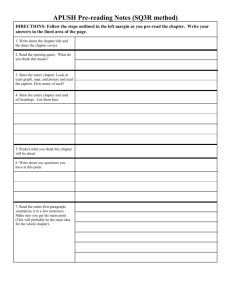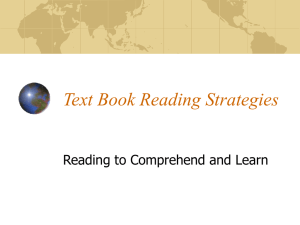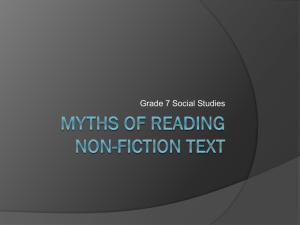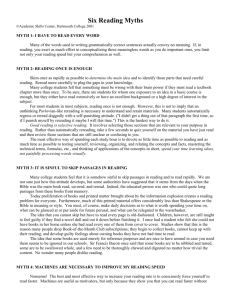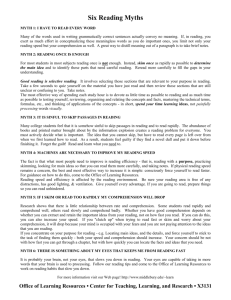An Adaptive Strategy for Reading on the Web
advertisement
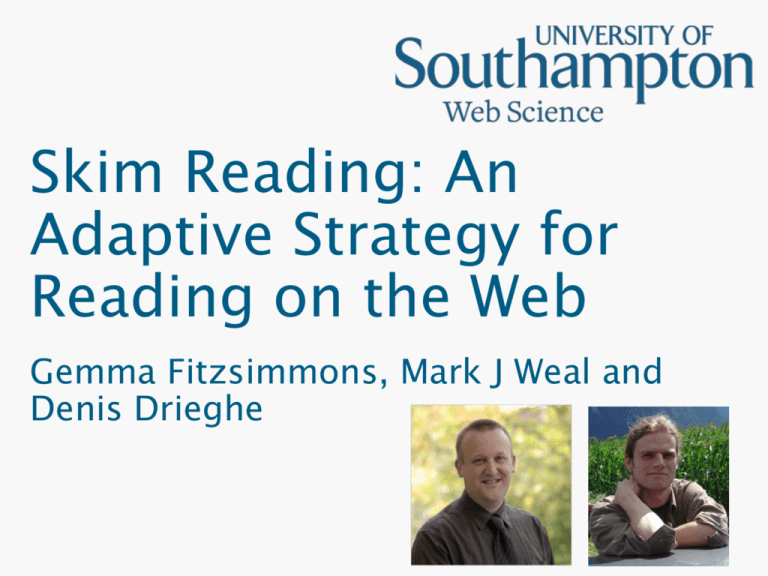
Skim Reading: An Adaptive Strategy for Reading on the Web Gemma Fitzsimmons, Mark J Weal and Denis Drieghe Why is it important to study reading on the Web? Users of the Web engage in a wide variety of different activities (Trend Data, 2012): – – – – searching for information reading the news/reading for comprehension sending and receiving email social networking Within all of these activities, the primary task that users engage in is reading text But we can read for comprehension, skim read or conduct a visual search for information 2 Present Experiment In the present experiment I am focusing on reading for comprehension vs skim reading on the Web With the large amount of information available to us on the Web we need a strategy to sort through all of the text presented to us 3 Speed-comprehension trade off Skim reading has been shown to negatively affect comprehension (Carver, 1984; Just & Carpenter, 1987 ; Dyson & Haselgrove, 2000) Others have shown that there is a difference between important and unimportant information. The important information does not receive the same loss of comprehension that the unimportant information receives (Masson, 1982; Reader & Payne, 2007; Duggan & Payne, 2009) To explain these findings, it was suggested that an adaptive satisficing strategy was being used to gain 4 as much information from the text in reduced time Information Foraging Pirolli and Card (1999) used a metaphor of a bird foraging for berries in patches of bushes as an example of information foraging. The bird must decide how long to spend on one patch before expending time moving onto a new patch to forage for berries. The problem is at what point does the bird decide to move from one patch to a new one? 5 Foraging – A Satisficing Strategy A satisficing strategy is where an individual is sensitive to their ‘information gain’ and uses this as a threshold In reading the reader searches for where information gain is high and when it drops below an acceptable threshold, they move on to a new patch of text In this experiment we explore whether a satisficing skim reading strategy is used when reading on the Web and whether hyperlinks have an impact on the strategy 6 Overview Eye movement methodology Research questions: – How does skim reading affect the way we read hypertext? – How does skim reading affect comprehension? 7 Anatomy of the Eye 8 Retina Retina contains photoreceptor cells: – Rods – peripheral vision/low light levels/detecting motion – Cones – fine detail in the centre of vision/colour vision 9 Eye Movement Methodology Due to the anatomy of the eye it is necessary that we make eye movements – Fixations – where the eye is steady and we can take in information – Saccades – where the eye is in motion and we are functionally blind Due to low acuity outside of the fovea we need to directly fixate anything, such as a word, in order 10 to process the information Eye movement example Not every word is fixated The length of each saccade varies The duration of each fixation varies 11 Reading Research Eye movement and reading research started in the 1970s and has substantial literature exploring how we read Rayner and Pollatsek (1989) found that the more difficult the text the longer the fixations and the shorter the saccades and more backward-directed eye movements (regressions) are made to re-read information Eye movements are a measure of online cognitive processing (Liversedge & Findlay, 2000) i.e. what is going on in our brains in reflected in our eye movements 12 The Present Experiment How does skim reading affect the way we read hypertext? 32 participants - 8 conditions (within) 2 (Task Type) x 2 (Word Type) x 2 (Word Frequency Word Frequency Task Type Read normally Word Type Skim read 13 Experimental Stimuli 14 Rating Pre-Experiment How does skim reading affect comprehension? Participants who did not take part in the main experiment were asked to rate each sentence on its importance From these ratings we created comprehension questions based on the two most important and two least important sentences After each trial participants were asked to respond to these comprehension questions 15 Example Trial Comprehension Q 1 Comprehension Q 2 0 Comprehension Q 3 Comprehension Q 4 16 Results - How does skim reading affect the way we read hypertext? Participants read significantly faster when they were skim reading (Normal=39 seconds, Skimming=20 seconds) We focused on the target word regions for the rest of the analysis to explore how our manipulations affected reading behaviour Linear mixed-effects models (LME) were used for the eye movement analysis (suited for missing data due to word skipping) 17 Eye Movement Measures Skipping Probability – Percentage the target word was skipped in first-pass reading Single Fixation Duration – Time spent on the target word to process it Go-past Times – Time spent on the target word, including re-reading before moving past the target word Bill kicked the football and scored a goal. 18 Results – Main Effects Significant effect of Word Frequency across all measures, low frequency words skipped less and fixated for longer No effect of Word Type, suggesting that linked word are not more difficult to process, replicating Fitzsimmons, Weal & Drieghe (2013) Effect of Task Type in Go-Past Times only, indicating that there was less re-reading in the skimming task 19 Results – Skipping Probability Interaction: Word Type x Task Type No difference between Word Type in Normal reading Unlinked word are skipped significantly more often than linked words in the Skimming condition 20 Results – Single Fixation Duration Interaction: Word Frequency x Word Type x Task Type Fixation times shorter when skimming When reading normally there is a Word Frequency effect in both Linked and Unlinked words However, when skim reading a Word Frequency effect is only observed in Linked words 21 Discussion - How does skim reading affect the way we read hypertext? Participants read faster when skim reading Links had an effect on skim reading Links less likely to be skipped and more likely to be fully processed compared to unlinked words when skim reading Are links important? 22 Results - How does skim reading affect comprehension? Significant main effect of Task Type Comprehension significantly decreased when skim reading Marginal effect of importance – Accuracy was improved slightly for important sentences 23 Discussion - How does skim reading affect comprehension? Comprehension decreases when skim reading Comprehension is marginally improved for important sentences Important sentences contain more links Participants may have been prioritising important sentences and using links as markers to which sentences were important 24 General Discussion Eye movement results suggest that the reader is focusing on the linked words while skim reading Together, the eye movement results and comprehension results suggest that the reader may be using an adaptive strategy to read quickly while attempting to maintain comprehension 25 General Discussion There were more links in the important sentences The reader could be using links as markers to find the important information in the text in order to engage in an optimal strategy for gaining information This means we need to consider what words we use as links 26 Future Research Clicking and navigating through Webpages Other Webpages that are not Wikipedia – not all Webpages contain so many hyperlinks in the text where you can assume the destination is another similar Wikipedia page Task effects – reading for comprehension vs skim reading vs searching for information 27 Thank you for your attention! Any questions? 28 Appendix – Eye movement means 29 Appendix – Skipping Probability Main effect qualified by a significant interaction between Word Type x Task Type 30 Appendix – Single Fixation Duration Main effect qualified by a significant interaction between Word Frequency x Word Type x Task Type 31
